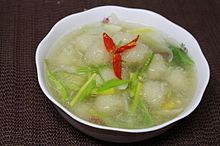food.wikisort.org - Dish
Gamja-ongsimi (감자옹심이) or potato dough soup is a variety of sujebi (hand-pulled dough soup) in Korea's Gangwon cuisine.[1][2] Both the potato dumplings (or potato balls) and the soup, together can be referred to as gamja-ongsimi. The juk (porridge) made with potato balls as its ingredient is called gamja-ongsimi-juk,[3] and the kal-guksu (noodle soup) made with the potato balls is called gamja-ongsimi-kal-guksu.[4]
 | |
| Type | Sujebi |
|---|---|
| Place of origin | Korea |
| Region or state | Gangwon Province |
| Associated national cuisine | Korean cuisine |
| Main ingredients | Potatoes |
| Korean name | |
| Hangul | 감자옹심이 |
|---|---|
| Revised Romanization | gamja-ongsimi |
| McCune–Reischauer | kamja-ongsimi |
| IPA | [kam.dʑa.oŋ.ɕi.mi] |
Etymology and history
Gamja (감자) means potatoes, and ongsimi (옹심이) is a Gangwon dialect word for saealsim (새알심; literally "bird's egg", named for its resemblance to small bird's eggs, possibly quail eggs), which is a type of dough cake ball often made with glutinous rice flour and added to porridges such as patjuk (red bean porridge) and hobak-juk (pumpkin porridge).[1] Originally, gamja-ongsimi was made into small balls as saealsim, but nowadays it is also made into bigger, less globular, and more sujebi (hand-pulled dough)-like shapes.[1]
Preparation
Potatoes are grated, drained, squeezed, and mixed with the potato starch settled at the bottom of drained water in a bowl.[5] The potato dough is balled into ongsimi, and boiled in anchovy-dasima broth with vegetables such as aehobak (Korean zucchini), shiitake mushrooms, shepherd's purse, and red chili peppers.[2][5] The soup is often topped with gim-garu (seaweed flakes), toasted sesame seeds, and optionally white and yellow al-gomyeong (egg garnish).[5]
Gallery
- Gamja-ongsimi (potato dumpling soup)
- Deulkkae-gamja-ongsimi (potato dumpling soup with perilla seed broth)
- Gamja-ongsimi-kal-guksu (potato dumpling and noodle soup)
- Gamja-ongsimi topped with gim-garu (seaweed flakes) and toasted sesame seeds, served in ttukbaegi (earthenware)
See also
- Kal-guksu
- Silesian dumplings
- List of potato dishes
References
- "gamja-ongsimi" 감자옹심이. Doopedia (in Korean). Doosan Corporation. Retrieved 5 May 2017.
- 황, 재희. "gamja-ongsimi" 감자옹심이 [potato dough soup]. Digital Local Culture Encyclopedia of Korea (in Korean). Retrieved 5 May 2017.
- "gamja-ongsimi-juk" 감자옹심이죽. Doopedia (in Korean). Doosan Corporation. Retrieved 5 May 2017.
- "gamja-ongsimi-kal-guksu" 감자옹심이칼국수. Doopedia (in Korean). Doosan Corporation. Retrieved 5 May 2017.
- 정, 혜경. "gamja-ongsimi" 감자옹심이. Encyclopedia of Korean Culture (in Korean). Academy of Korean Studies. Archived from the original on 25 March 2012. Retrieved 5 May 2017.
Другой контент может иметь иную лицензию. Перед использованием материалов сайта WikiSort.org внимательно изучите правила лицензирования конкретных элементов наполнения сайта.
WikiSort.org - проект по пересортировке и дополнению контента Википедии



